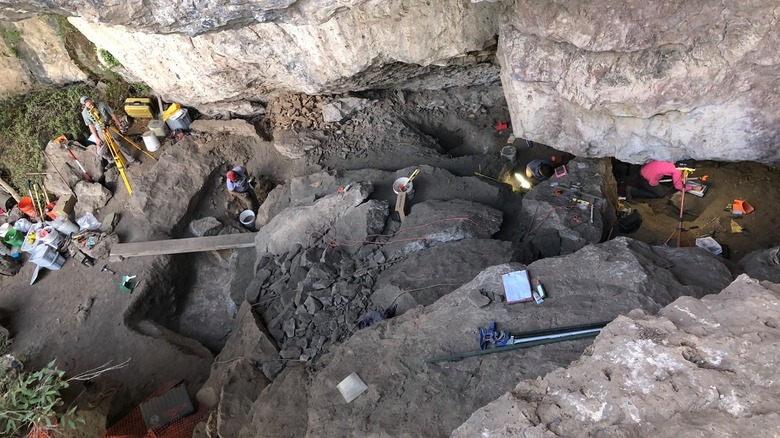The Ancient Weapons Found Near A Small, U.S. Desert Town
Finding the tools of early humans that have been left behind uncovers details about how human civilizations have evolved over centuries and even millennia. In the Big Bend region of southwest Texas, a collaboration of archeology teams has discovered a near-complete set of hunting tools made from wood and stone, giving scientists insight into the lives of the area's earliest residents more than 6,000 years ago.
Together, teams of researchers from the University of Kansas' Odyssey Archaeological Research Fund (OARF) and the Center for Big Bend Studies (CBBS) at Sul Ross State University pulled the hunting kit from the back of a partially collapsed cave dubbed the San Esteban Rockshelter just south of Marfa, Texas. The kit included a straight flying boomerang (the oldest-known of its kind), a partial atlatl (also called a spear-thrower and one of the innovative discoveries of the Paleolithic Age), four dart nock ends, four hardwood foreshafts, and six stone-tipped foreshafts. The dart foreshafts fit to the main dart shaft with socket ends, but those ends are missing, preventing the researchers from completely understanding how these pieces attach. Also missing in the kit is the handle end on the atlatl.
CBBS director Bryon Schroeder told Texas Parks & Wildlife magazine, "If it really is a contemporaneous kit, it's a pretty monumental finding." Schroeder explained that the tools could be used to gain insights to the environment at the time and how long it took the kit owner to make their tools. "We get these incredible snapshots of life, vignettes of how they lived, what the environment was and how they responded to it."
The hunting kit wasn't the only specimen discovered in the cave
Alongside the tools and weapons made from stone and wood found in the San Esteban Rockshelter, the CBBS and OARF teams retrieved some fossilized human feces called coprolites. This specimen, like many others unearthed around the world, can reveal interesting information and even change what scientists have surmised about the earliest humans in the Big Bend region, including who was living in the area and their diets.
Additionally, the researchers found bone fragments and a folded and tanned hide from a pronghorn, which is a hoofed animal related to antelope and goats and native to North America. It features holes around the perimeter that are spaced out for softening on a frame, as was common practice at the time. However, the most interesting part was that the fur was still intact and its original color, which may be attributed to the arid climate. When the team found the perfectly preserved hide, they were awestruck. Speaking to Texas Parks & Wildlife, Schroeder said, "That's a moment in time. It's akin to holding dish gloves that somebody put over the sink after doing the dishes. Somebody folded that hide up and sat that right on top of this rock. And nobody touched it for 6,000 years."
This certainly isn't the first discovery of old weapons found in the United States. In fact, the oldest gun ever found in the United States was unearthed in Arizona in 2020 and gives historians more details about the Coronado Expedition of Spaniards into North America from Mexico in the 16th century. And, future expeditions throughout the country are sure to unearth more.

